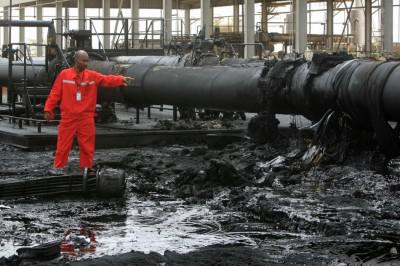
A worker inspects a damaged oil pump in Heglig. (Photo: Reuters/Mohamed Nureldin Abdallah)
Sudan and South Sudan took one step back from an all out war on Friday when South Sudanese President, Salva Kiir, agreed to withdraw military forces from the contested oil-producing town of Heglig, which was occupied by South Sudanese forces after fighting on April 3rd. Heglig is claimed by both Sudan and South Sudan and remains one of the many unresolved issues since South Sudan became the newest independent country in June 2011.
The dispute over Heglig is part of a larger conflict between the two countries over borders, as well as other unresolved issues such as the transportation of oil from South Sudan to the Port of sudan, the status of the 500,000 South Sudanese living in the north, claims of state support to ethnic militias by both countries, and, most recently, Sudan’s aerial bombardment of several towns inside South Sudan.
There are no winners in war — just different levels of losers. The latest flare up should not be considered an isolated event but rather part of a several decades long civil war, now involving two independent countries. However, the current dispute is somewhat different in that both sides are attempting to ensure maximum economic destruction. This conflict is all about oil and the potential revenues it generates in an otherwise poor and underdeveloped part of the continent.
The latest incident started in January 2012 when South Sudan completely shut down oil production after an ongoing dispute with Sudan over the cost of transporting the crude from landlocked South Sudan to the Port of Sudan in the north via pipelines. Sudan was demanding $35 a barrel — more than a third of the final price on the world market – while independent experts suggest the fee should be between 50 cents and $3.50. In addition, it became public knowledge that Sudan was clandestinely siphoning off oil for their own refineries, which the Sudanese government has since argued was taken as “payment in kind” for its pipeline services. Sudan and its southern neighbor have been locked in negotiations over how to split South Sudan’s oil revenues since the Comprehensive Peace Agreement, which dictated a 50/50 revenue split, expired in 2011.
South Sudan’s actions drew popular support at home but are not sustainable over the long term. 98% of South Sudan’s revenues come from the export of oil. The government and Parliament of South Sudan quickly passed an austerity budget. But perhaps austerity is the wrong word — given that there are numerous reports that the government’s budget is 1/3 larger than the previous budget.
Critics of South Sudan’s actions in January, the last time the country cut off its oil exports, often state that the Southern response was not well thought out, but perhaps this was the opening for the SPLA army incursion into Heglig. By taking over Hegling in March, 2012, South Sudan deprived Sudan of 50% of their current oil production of 50,000 barrels of oil per day. Given Sudan’s international isolation and continuing economic deterioration the two sides are trying to resolve their remaining issues through a war of economic attrition.

